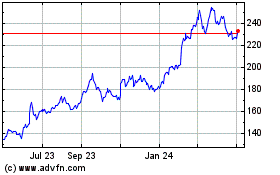Toyota Races To Improve Sales in U.S. -- WSJ
May 10 2018 - 3:02AM
Dow Jones News
By Sean McLain
This article is being republished as part of our daily
reproduction of WSJ.com articles that also appeared in the U.S.
print edition of The Wall Street Journal (May 10, 2018).
TOKYO -- Toyota Motor Corp. faces a rough road ahead in the U.S.
with declining sales of sedans and rising expenses threatening its
already razor-thin margin there.
The car maker said Wednesday its operating income in North
America in the year ended March 31 fell by more than half to Yen139
billion ($1.3 billion), largely owing to spending on incentives to
lure car buyers such as low-interest loans. That left it with an
operating margin of just 1.3%, compared with 8.2% for Toyota
globally.
A rapid shift in the U.S. car market toward trucks and
sport-utility vehicles has hammered Japanese car makers, forcing
them to choose between losing sales on less-popular sedans or
boosting incentives.
Chief Financial Officer Koji Kobayashi said Toyota was racing to
boost production of more-profitable trucks and SUVs such as the
RAV4.
"We are working hard to re-establish the earnings structure in
North America," Mr. Kobayashi said. "What we are aiming at is
hitting 8% by 2020" in operating-profit margin.
For the current fiscal year, ending March 2019, Toyota expects
sales in North America to remain almost flat at 2.8 million
vehicles.
The company's new Camry sedan is an example of the challenge.
Sales of the vehicle grew while those of its main competitors
shrank, but the growth was fueled in part by spending more than
$2,000 in incentives on every one it sold.
Incentive spending will still be needed to maintain sales, said
Mr. Kobayashi. And other costs continue to weigh down earnings in
the U.S.
Cheap leases fueled by years of low interest rates provided a
boost to U.S. car sales. Those vehicles are being returned as the
U.S. car market plateaus, driving down their value. Many of these
vehicles are worth less than Toyota anticipated, forcing it to book
a loss, the company said.
To match production with demand, Toyota plans to spend nearly $1
billion upgrading its RAV4 factories in Canada. It is introducing
the latest version of its most popular vehicle later this year. A
plant in Mexico is slated to begin producing Tacoma pickup trucks
in 2019.
Elsewhere, Mr. Kobayashi said Toyota wanted to narrow the gap
with Japanese rivals in China. Honda Motor Co. and Nissan Motor Co.
now sell nearly as many cars in China in the U.S. By comparison,
Toyota sold more than twice as many cars in the U.S. as in
China.
The company recently said it would introduce 10 plug-in hybrid
and electric vehicles in China in the next several years, including
a battery-powered version of its compact C-HR sport-utility
vehicle.
Outside North America, Toyota is in good health. It recorded a
net profit of nearly Yen2.5 trillion ($22.7 billion) in the year
ended in March, partly helped by one-time gains connected to U.S.
tax changes. For the current fiscal year, net income is projected
to decline 15% to Yen2.1 trillion.
To insulate itself from the risks of a stronger yen, Toyota is
looking for Yen300 billion to Yen400 billion in annual savings, Mr.
Kobayashi said.
It aims to apply lessons from the factory floor to the head
office. Just as Toyota's fabled production system is designed to
continuously reduce costs, white-collar workers are being told to
cut back on paperwork and meetings, said Shigeki Terashi, a Toyota
executive vice president.
One measure of progress: Executives are no longer handed large
stacks of briefing materials ahead of weekly strategy meetings.
Instead, they receive a sheet of paper with the key talking points,
said Mr. Kobayashi.
Write to Sean McLain at sean.mclain@wsj.com
(END) Dow Jones Newswires
May 10, 2018 02:47 ET (06:47 GMT)
Copyright (c) 2018 Dow Jones & Company, Inc.
Toyota Motor (NYSE:TM)
Historical Stock Chart
From Jun 2024 to Jul 2024

Toyota Motor (NYSE:TM)
Historical Stock Chart
From Jul 2023 to Jul 2024
